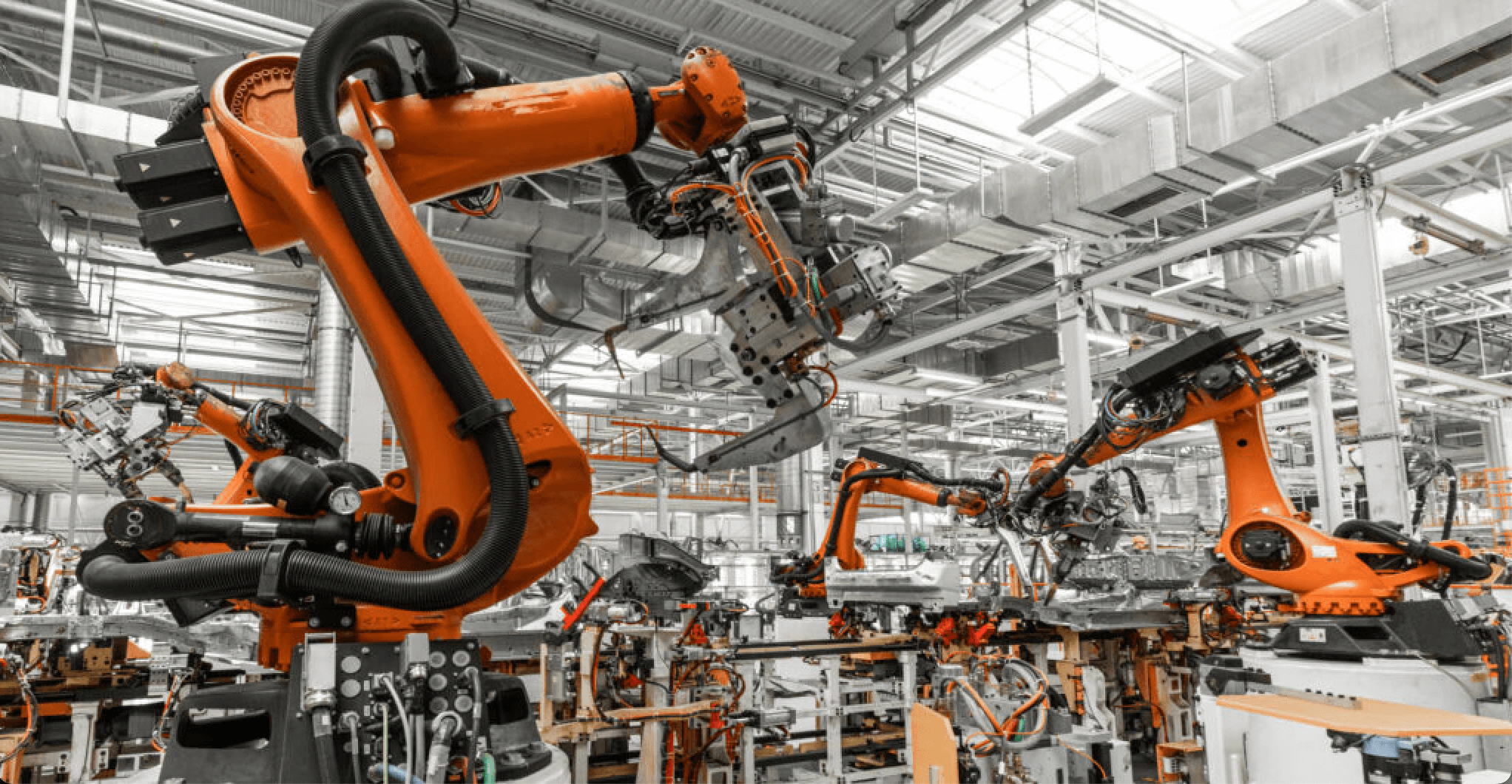Industrial automation is the use of computer‑based control systems, or sometimes even analog ones. It’s about letting machines manage themselves with minimal human intervention.
It involves using machines, robots, and software to perform tasks that usually back then were performed by humans.
Core Components & How It Works
At the core of industrial automation systems are devices and technologies that monitor, control, and execute tasks, replacing or reducing the need for human intervention.
This includes hardware like PLCs (Programmable Logic Controllers), sensors, actuators, robotic arms, HMIs (Human-Machine Interfaces), and software systems such as SCADA (Supervisory Control and Data Acquisition) and DCS (Distributed Control Systems).
PLCs are industrial-grade computers that take input from sensors (such as temperature, pressure, or position sensors), execute programmed logic, and drive actuators (like valves, motors, or lights) accordingly.
The control strategy can be simple—such as turning off a motor when a temperature threshold is reached—or complex, such as coordinating an entire assembly line with hundreds of input/output points.
This is where SCADA systems or DCS platforms come in: they gather data from multiple PLCs or controllers, offer visualization dashboards, allow operators to supervise and control processes remotely, and provide historical logging for quality assurance and diagnostics.
Another major component is CAD/CAM (Computer-Aided Design and Manufacturing), which not only designs parts but also feeds into CNC (Computer Numerical Control) machines and automation paths. This seamless integration is a hallmark of advanced automation.
This control can be analog (e.g., pneumatic regulators, PID loops using analog signals) or digital (as in PLCs).
The ultimate goal remains the same: orchestrate all system components to operate autonomously and precisely.
Types of Industrial Automation
Industrial automation isn’t one-size-fits-all. Depending on production needs, scale, and complexity, different types of automation systems are implemented. These fall into four primary categories:
Fixed (Hard) Automation
This type is designed for high-volume, repetitive tasks. The machinery is configured for a specific process and cannot be easily changed.
Examples include automotive assembly lines or bottling plants. Fixed automation is known for high throughput but lacks flexibility.
Programmable Automation
Here, machinery can be reprogrammed to accommodate changes in product design or production sequence.
It’s widely used in batch production, for example, in chemical or food industries. Reprogramming takes time and cost, but it offers more adaptability than fixed automation.
Flexible (Soft) Automation
Flexible systems, often found in CNC machining and robotic systems, can easily switch between different product types.
The transition requires little to no downtime. This is where robots with vision systems, AGVs (Automated Guided Vehicles), and flexible manufacturing systems shine.
Integrated Automation
This is the future-focused approach combining all levels, from field devices to enterprise resource planning (ERP).
It leverages digital communication, centralized control, and software platforms like MES (Manufacturing Execution Systems) and IIoT (Industrial Internet of Things).
Integrated automation enables real-time data-driven decision-making, predictive maintenance, and seamless cross-system interaction.
Each automation type reflects a different degree of self-management and adaptability. The more integrated and flexible the system, the closer we get to fully autonomous industrial environments.
Benefits & Impact
Industrial automation makes machines run themselves, reducing human involvement to the essentials.
It enhances accuracy, efficiency, productivity, and safety while lowering operational costs.
It will increase accuracy, efficiency, productivity, and safety, and at the same time, we reduce the operational cost for our factories.
Automation frees workers from dangerous or monotonous tasks, enabling them to focus on higher‑value roles.
Enabling Trends: Industry 4.0 & IIoT
Industrial automation is being revolutionized by the Fourth Industrial Revolution, Industry 4.0, with smart devices, M2M communication, AI, and cloud integration.
Concepts like IIoT, digital twins, machine learning, and industrial robotics make production smarter, safer, and more adaptable.
Safety, Challenges & Future Outlook
Using PICs and SCADA in safety‑critical environments requires robust protocols and regulatory compliance. Cybersecurity risks (e.g., PLC vulnerabilities) are significant.
High upfront costs and complexity of integration can be barriers, yet trends like flexible and integrated automation systems lower these hurdles.
Looking ahead, expect growth in AI-driven automation, digital twin simulations, and fully lights-out smart factories.
FAQ: What Is Industrial Automation?
What is an example of industrial automation?
A classic example of industrial automation is a robotic assembly line in an automotive plant.
Robots handle tasks like welding, painting, or assembling parts with minimal human oversight.
These systems rely on PLCs, sensors, and actuators to perform repetitive actions with speed and precision.
What is automation in the industry?
Automation in the industry refers to the use of machines, software, and control systems to perform tasks that traditionally required human labor.
This includes monitoring processes, adjusting equipment, handling materials, and even making decisions based on real-time data.
What are the four types of industrial automation?
The four primary types of industrial automation are:
- Fixed Automation – High-volume, repetitive tasks (e.g., vehicle assembly lines).
- Programmable Automation – Customizable control systems for batch production.
- Flexible Automation – Rapidly adjustable systems for varying products.
- Integrated Automation—Fully networked and data-driven production environments.
Each of these represents a different approach to reducing manual labor and enhancing production flexibility.
These systems scale from rigid to highly adaptive setups depending on the industry’s needs.
What is a PLC in automation?
A PLC (Programmable Logic Controller) is a rugged industrial computer used to automate processes by monitoring inputs and controlling outputs based on a custom logic program.
They’re essential in managing repetitive tasks like turning motors on/off, adjusting valves, or reading sensor signals.
In practical use, “the use of PLC” is one of the most fundamental tools in industrial automation.
These controllers provide the decision-making brain of the system, ensuring operations run smoothly and according to programmed logic—even in harsh industrial environments.
Conclusion: What Is Industrial Automation?
Industrial automation means letting machines self-manage critical processes. It combines PLCs, robots, sensors, control systems and software to deliver safer, more accurate, efficient, and lower-cost operations.
As IIoT, robotics and AI advance, automation will only deepen its impact across industries.

